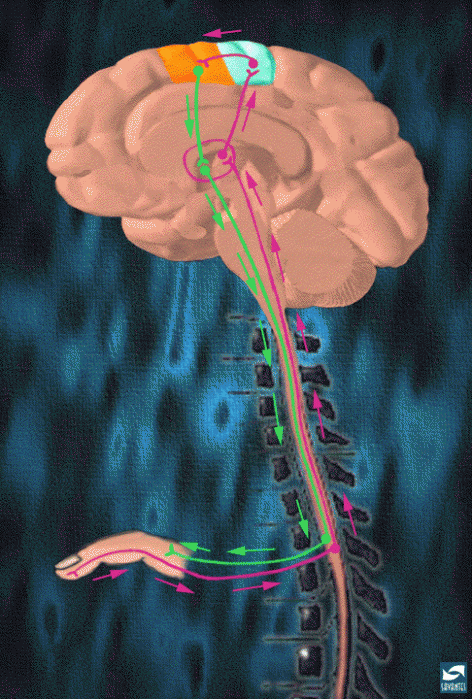The Human Physiology of Pain and Analgesic System
Imagine you were walking down a path and mistakenly stepped on a spiky object, let say a 3.5 inches long nail. Or maybe you got bitten while feeding your dog. You would agree that the next few minutes after such incidence would be practically unbearable. The feeling is characterized by utmost discomfort which can last for days or even weeks. In most cases this discomfort has the ability to render you restless or underactive for a time being. This discomfort is universally known as pain.
Pain is defined as an experience of physical or emotional discomfort which can be traced to an actual tissue damage and in some cases, there is no tissue damage.. Humans and mammals are adapted to experiencing pain in many different ways. Pain can exist in form of electrical , stabbing, cutting or shooting sensations. Descriptions of pain vary on the tissue involved and the actual causes of the experience.

I choose this picture because the man dispict how pain can be unpleasant nd sometimes unbearable!
License: CC0 - Source: pexels.com
As much as pain can be very unpleasant, it is a vital part of our existence. And our existence isn't complete without irritability (which is the ability to respond to stimulus). Try visualizing a person whose head is on fire but can’t feel any pain. Or a person who forgot his hand on a barbecue grill- the result could be undebatably disastrous: Pain in these situations help to reduce the potential damage to body tissue by alerting the person of the existing danger. In some cases where there is no actual damage yet, pain serves to warns the person of the potential threat.
In our society which is becoming more industrious with people becoming more occupied, we tend to seek the easiest route out of everything. Time is money and nobody wants to decisively take a deliberate break. Pain is very useful in this situation as it can force a person to take a bed rest thereby minimizing damage to the body. During this rest, the body undergoes a rapid healing program. In a number of cases, the person is urged to seek professional help.
There are different ways in which pain felt by humans can be classified. Classification is essential to better understand pain in the body and to as well device ways of treating underlying conditions.

Licence: CC0 - Source: pexels.com
Anatomical classification another method of classifying pain. It is the most commonly used method used by people especially children. This pain classification method is described on the basis of the body part in which the pain is arising from. Example includes muscle pain, stomachache, headache, myofascial pain, shoulder pain, back pain, neck pain and leg pain.
Pathophysiological classification classifies pain depending on if the pain is nociceptive or neuropathic. Nociception is defined as the response of the body to potential or actual pain. Nociceptive pain is generated by the activation of nociceptors which are pain receptors scattered around the body tissues. These receptors are activated by chemical, thermal and mechanical stimuli which the body perceives can be harmful. Furthermore, nociceptive pain can be further classified to be somatic or visceral. Somatic pain arises from pain receptors (nociceptors) localized in the skin, bones, ligaments, tendons and joints. Visceral pain arises from stimulation of nociceptors localized in the internal organs such as the stomach, lungs, pleura, heart and intestines.
Pain in visceral organs is mainly produced from chemical stimulations of the visceral nociceptors. During inadequate supply of blood to an organ or area of the body, chemical substances such as bradykinin is released into the blood to enlarge the required blood vessel (and this in turn increases blood flow to organ deprived of adequate blood supply). At the same time, bradykinin stimulates pain by stimulating visceral nociceptors of the organ. Leakage of acidic gastric juice from the stomach during peptic ulcer explains the pain felt by ulcer patient (NB: this is not the only cause of pain in ulcer patient. Peptic ulcer patient feel pain as well when the mucous lining of the stomach is eroded causing the stomach tissue to come in direct contact with the corrosive gastric juice and digestive proteolytic enzymes). Pain in the visceral can also arise spasmic contraction of visceral smooth muscles, thermal changes and mechanical injury.
Neuropathic pain which is the second type of pathophysiological pain transpires due to damage or abnormal functioning of the nervous structures. This pain can be peripheral- affecting the peripheral nerves, dorsal root or dorsal root ganglion and it can be central neuropathic affecting the brain or spinal cord. This pain results from lesion of structures in the nervous system or diseases.
How the body processes pain.

Pain pathway colored in pink, other pathway if for motor codination of body.
Source:drugabuse.gov
The pain sensation from the face is transmitted by the trigeminal nerve. Trigeminal nerve or the cranial nerve V is a somatosensory nerve which relays both commands from the brain to the structures of the face and sensations from the face to the brain. Motor commands such as biting and chewing equally sensory information such as temperature and pain are relayed through this nerve which happens to be the largest cranial nerve. Sensory fibers of the trigeminal nerve receives sensory information from the nasal and oral cavities, face and teeth, Dura mater and other areas to the sensory cortex of the brain where information are properly interpreted.
Sensory fibers from different part of the body with exception of the head pass through a posterior nerve root of the spinal cord and ascends as a bundle of tracts to thalamus and sensory cortex of the brain. The role of the thalamus in nociception is to accurately relay sensory information coming from the ascending tracts of the spinal cord to the proper region of the brain for interpretation. The pathway of pain from the skin begins with the free nerve endings which are found in the skin. These free nerve ending then transmit impulses to the neuron which relays these information to the spinal cord through the posterior ganglion. Pain from the abdominal organs as well as thoracic organs is transmitted by the sympathetic nerves. While pains from the esophagus, pharynx and trachea are relayed by the vagal nerve. Sacral parasympathetic nerves relay pain from structures of the pelvic region to the brain.
These nerves connected directly to the organs are referred to as the first order neuron and they terminate in the posterior gray horn of the spinal cord. A new set of tract/fibers arises to continue relaying these sensory information, they are referred to as the second order neurons- they terminate in the thalamus. From the thalamus, the pain pathway continues as the third order neuron and extends to the proper structures of the brain for interpretation.
Remember Ajax from Deadpool I, the evil scientist who mutates everyone? There are people who have his ability- not as a superpower but a congenital condition.

Source: Internet Movies Database-- Copyright belongs to 20th Century Fox.
Hit them an hammer in the head, or cut off their arm from their body awake- they would feel movements but not pain. It results from a mutation of the gene SCN9A. This condition rather than being helpful is considered dangerous. A person who does not feel pain won’t be able to retreat from danger. The person also would not know if there is a problem with any internal structure and to what degree. Children with this condition are at a greater risk- they can't are prone to harming themselves. These children have been noted to biting their tongues off. Watch the video below for better understanding of the disease.
Author: mallikamarshall - Source: Youtube
We have an analgesic pathway
This is a mechanism employed by the body to reduce intensity of pain experienced by an individual- it is simply a pain control or modulating system. The body has its own endogenous analgesic system in the brain. It is made up of a pathway through which synaptic transmission of pain sensation is interfered- pain sensation is blocked and an individual does not feel pain. This interference is made up of a descending pain pathway compared to the ascending pain pathway to the sensory cerebral cortex. Many of the analgesic drug used act on this system.
Oploids are a class of drugs that help relief pain (anesthesia). They create an effect by binding to an oploid receptor which are dominantly localized in the central and peripheral nervous system. They pose a psychoactive effect in the nervous system altering the perception of pain. Dosages of oploids are strictly monitored as they can be addictive. Examples of oploids include codeine, morphine, hydrocodone and heroine.
Sources:
Thanks for stopping by!
I appreciate you reading this article on pain and how the body react to it. I hope you learned something. Please, feel free to say and share your thoughts in the box below (I guess that's what the box is for). And do not forget to appreciate by upvoting the post. All constructive criticism would be appreciated and noted. Thank you, @damzxyno.
Congratulations @damzxyno! You have completed the following achievement on the Steem blockchain and have been rewarded with new badge(s) :
Click here to view your Board of Honor
If you no longer want to receive notifications, reply to this comment with the word
STOPTo support your work, I also upvoted your post!
Do not miss the last post from @steemitboard:
Congratulations! This post has been upvoted from the communal account, @minnowsupport, by Damzxyno from the Minnow Support Project. It's a witness project run by aggroed, ausbitbank, teamsteem, someguy123, neoxian, followbtcnews, and netuoso. The goal is to help Steemit grow by supporting Minnows. Please find us at the Peace, Abundance, and Liberty Network (PALnet) Discord Channel. It's a completely public and open space to all members of the Steemit community who voluntarily choose to be there.
If you would like to delegate to the Minnow Support Project you can do so by clicking on the following links: 50SP, 100SP, 250SP, 500SP, 1000SP, 5000SP.
Be sure to leave at least 50SP undelegated on your account.
This post has been voted on by the SteemSTEM curation team and voting trail in collaboration with @curie.
If you appreciate the work we are doing then consider voting both projects for witness by selecting stem.witness and curie!
For additional information please join us on the SteemSTEM discord and to get to know the rest of the community!
Thanks for the appreciation @steemstem. I already voted for the project witness!
Thanks you!
Hi @damzxyno!
Your post was upvoted by @steem-ua, new Steem dApp, using UserAuthority for algorithmic post curation!
Your UA account score is currently 0.801 which ranks you at #60353 across all Steem accounts.
Your rank has dropped 54 places in the last three days (old rank 60299).
In our last Algorithmic Curation Round, consisting of 425 contributions, your post is ranked at #392.
Evaluation of your UA score:
Feel free to join our @steem-ua Discord server